August 16, 2018
List of Blogs
|<
<
>
>|
|
|
Late Summer Gardening: The Lowdown
|
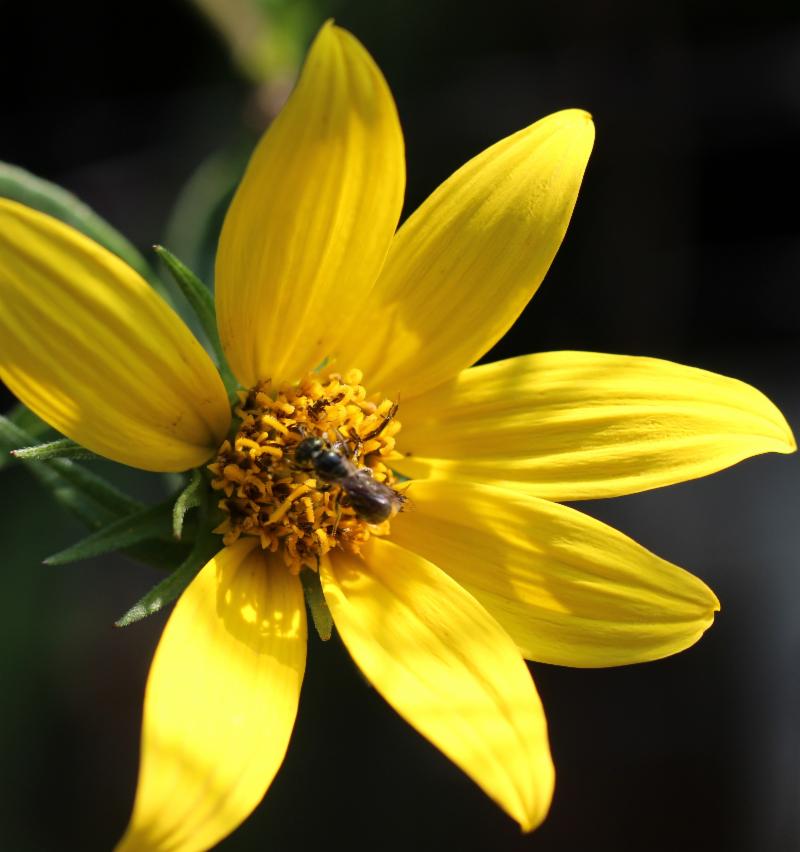
Woodland Sunflower (Helianthus divaricatus)
can handle a variety of conditions, and forms gorgeous groups of bright yellow flowers
in the late summer.
|
|
So, it's August, and somehow despite all of your best efforts, you didn't
manage to get as much gardening done this summer as you wanted to. Welcome
to the club! Often, by August, it feels too late to do anything about it, but
this isn't the case at all. Perennials, by definition, are plants that come
back year after year, and fall is actually the best time of year to plant them.
Planted properly and treated with some judiciously used mulch, you can plant
right up until the ground freezes - I certainly do! Even planting dormant
plants works very well. The vigorous roots will settle in through the fall
and winter, and the plants will re-sprout quite happily in the spring, giving
you an enormous leg up on how your gardens look going into next year.
|
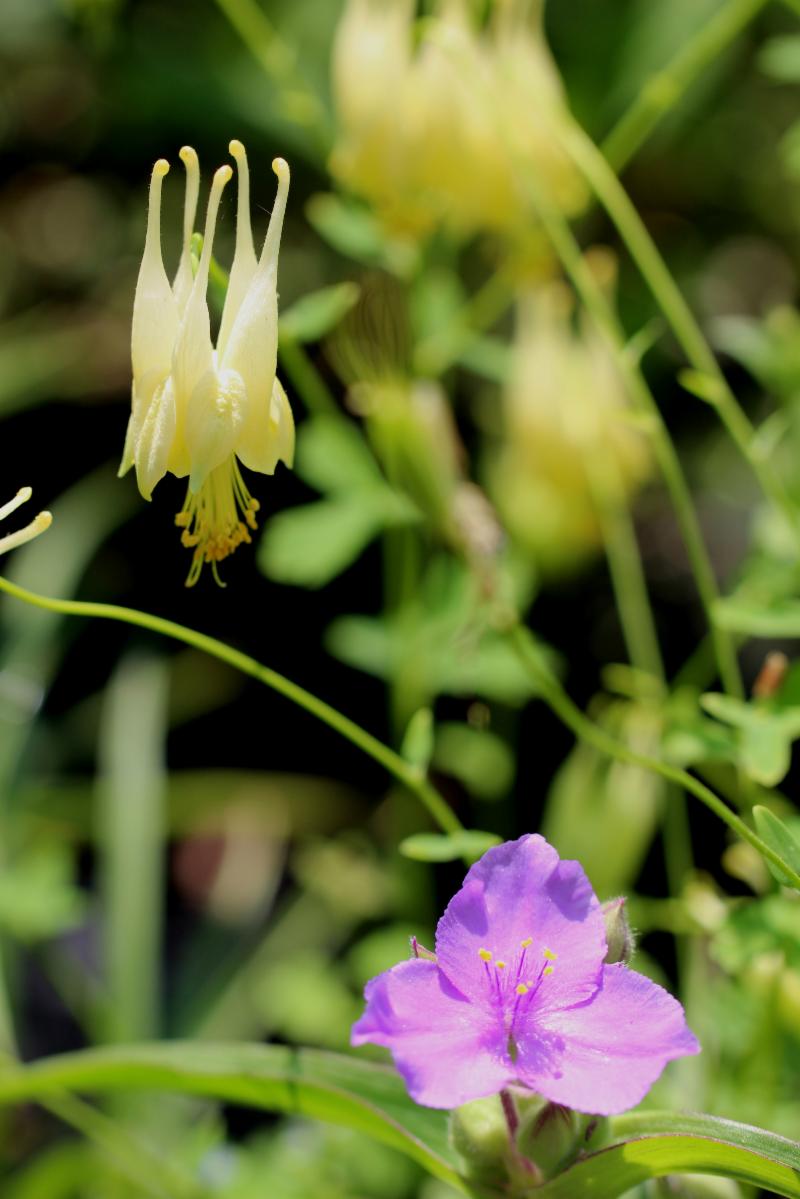
Golden Eastern Columbine (Aquilegia canadensis var.
corbett) and Prairie Spiderwort (Tradescantia bracteata) make for a nice color
combination in the early summer.
|
|
Of course, you don't have to plant perennials in the fall, but they certainly won't
complain if you do! There are many different kinds of perennials, so it's difficult
to generalize entirely, but you can think of a perennial plant's root system sort of
like an overwintering bear. Plants store up energy in their roots during the summer
months. When the plant 'hibernates' (goes dormant) in the fall, the leaves (and in
the case of most herbaceous perennials, the stems) die. The root remains vital and
holds all of that energy in reserve for the plants' return in the spring.
As a matter of fact, folks who start herbaceous perennials from seed are often surprised
when their new plants don't flower the first year. Those plants are simply prioritizing!
In their first year, many perennials put all of their spare energy into building their
new root system, to help them make it through the first winter.
|
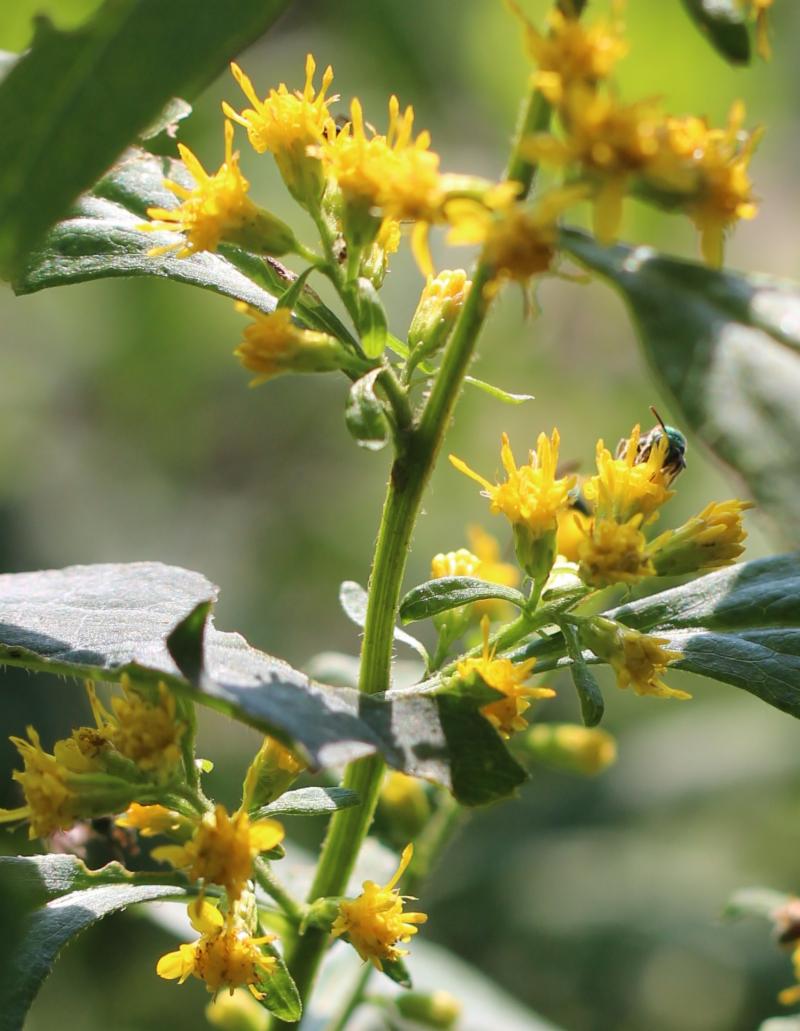
Goldenrods like this Zigzag Goldenrod (Solidago flexicaulis)
have beautiful yellow blooms that are a crucial source of nectar and pollen for pollinators in the fall.
|
|
But What About Plants that Bloom in the Fall?
Of course, planning your garden for next year is all well and good, but another important
aspect of fall gardening is keeping your garden interesting through the very end of the
season. Pollinators in the fall rely on late-flowering plants, and nothing supports pollinators
better than native plants: native insects and native plants evolved together, after all.
The good news is, there are lots of gorgeous late-flowering native plants. The better news
is that Goldenrods (Solidago sp.), which are some of the best supporters of pollinators
in the fall, are not actually what make you sneeze if you have fall allergies. Goldenrods
often get blamed for fall allergies, but the truth is that the major cause of fall allergies
(Ragweeds, Ambrosia sp.) have such inconspicuous flowers that most people don't even
know they're there; it seems more intuitive to blame the large yellow flowers of goldenrods,
which bloom at exactly the same time. Goldenrods, however, are not wind-pollinated, meaning
that they're not a source of airborne pollen at all! They rely on pollinators to manually
carry their sticky pollen from flower to flower, and pollinators likewise rely on goldenrods
as one of the last available sources of pollen and nectar in the fall. The upshot?
Don't fear the goldenrod!
|
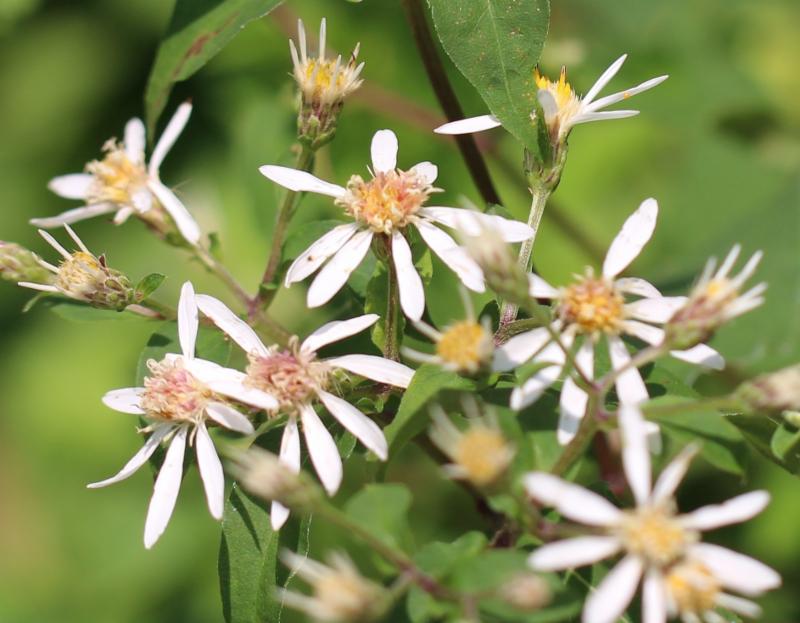
Plants like this White Wood Aster (Eurybia divaricata)
can make adorable additions to your fall plantings.
|
|
Native plants support wildlife through the late fall and winter
Of course there are lots of other fall-flowering native plants, such as the great variety
of native aster species (Symphyotrichum, Eurybia, Dollingeria, &
Ionactis sp.). Many of these will continue to bloom until well after the first
frosts, providing beauty and supporting pollinators late into the fall. But there's
more you can do to keep your garden interesting late in the season than simply
planting late-flowering plants. Goldfinches (Spinus tristis) start feeding
on the seedheads of most species of native sunflower (Helianthus sp.) and
coneflower (Rudbeckia and Echinacea sp.) before the flowers have even
lost their petals (so don't deadhead those flowers!) and seed-eating birds will
visit your spent flower heads and grass heads all winter long to feed. Many birds,
including Cedar Waxwings (Bombycilla cedrorum), rely on the persistent
fruits of plants like Viburnums (Viburnum sp.) and Redcedar trees
(Juniperus virginiana). In fact, if you have trees with many berries still
hanging on in the middle of the winter, occasionally you'll see Cedar Waxwings
flocking spectacularly to eat all of the remaining berries. Greenbrier
(Smilax sp.), Wild Grape (Vitis sp.), Hackberry
(Celtis occidentalis)...the list of native plants that support winter
wildlife goes on and on.
|
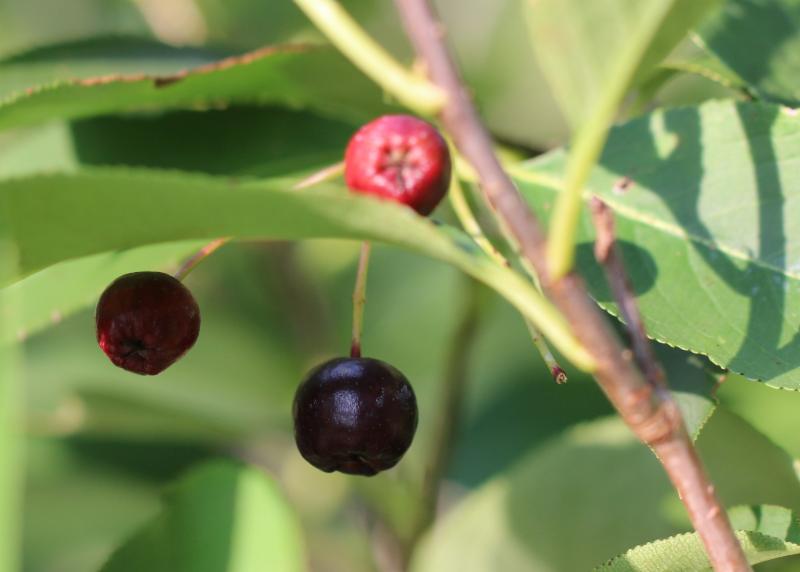
Purple Chokeberry (Aronia prunifolia), pictured here,
is an excellent source of food for birds, as are both Black & Red Chokeberry
(A. melanocarpa & A. arbutifolia)
|
|
A note: This is yet another reason not to plant invasive species, but instead
remove and replace existing invasive fruit-bearing plants with native plantings.
First of all, birds may not even recognize the fruits of invasive species as food.
But if they do, birds become a seed dispersal mechanism in and of themselves.
The birds ingest the fruits, the hard seeds pass through their digestive systems,
and they spread the seeds far and wide as they fly off in search of more food.
This is one of the ways Oriental Bittersweet (Celastrus orbiculatus),
Autumn Olive (Elaeagnus umbellata), Privet (Ligustrum sinense),
and many other invasive species have become such widespread problem plants in
otherwise healthy woodlands!
|
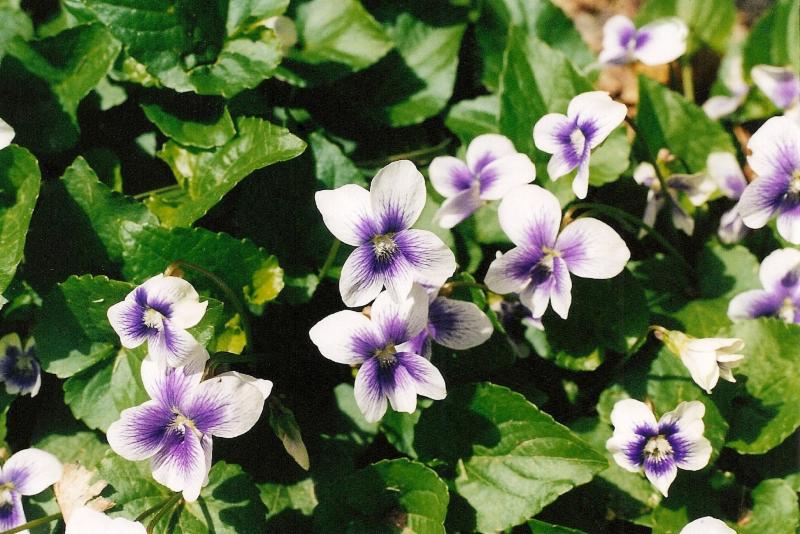
Confederate Violets (Viola sororia var. princeana)
are a gorgeous little spring-blooming plant that support early life stages of Fritillary butterflies,
and can also serve as an attractive groundcover.
|
|
Winter Doesn't Last Forever
Another thing to think about when designing your garden space is early spring flowers.
Planting late-fall blooms like goldenrods and asters goes a long way to supporting
your native pollinators, but in the spring, pollinators will emerge looking for
nectar and pollen as well. Violets (Viola sp.), Wild Eastern Columbine
(Aquilegia canadensis), Wild Stonecrop (Sedum ternatum),
and other early-flowering spring natives can fill this niche. And as with most
perennials, there is still plenty of time to plant these yet this fall.
There are many advantages to planting your spring blooming flowers in the fall:
early spring gardening, as we all know, can be tricky (Is the ground thawed yet?
Is it too muddy to plant?). If you plant in the fall, your early spring
wildflowers will already be in place and will re-emerge and flower exactly
at the right time for your garden conditions. They've evolved for this, they'll
get it just right. And being native plants, this will be exactly when the spring
pollinators have evolved to look for their blooms!
|
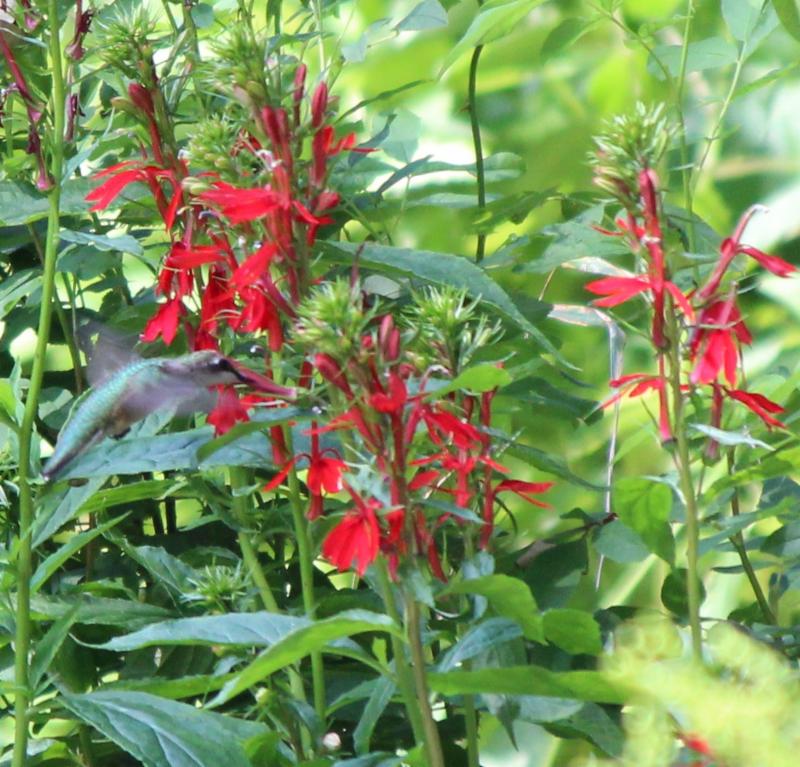
Cardinal Flowers (Lobelia cardinalis) are a
particular favorite of Ruby-throated Hummingbirds (Archilochus colubris)
at Toadshade.
|
|
Fearless Planting
So go ahead and keep gardening right up through the fall. You, your pollinators, and your
birds will reap the benefits all year long!
|
|
|



